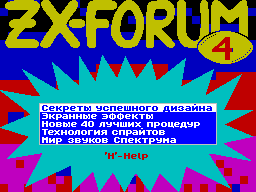|
ZX Forum #04
19 ноября 1997 |
|
Technology sprites - Part 3: Format of sprites.

These different Sprite
The time has come to deal with
formats sprites and methods
store them. We are with you most of the sprites found by
Search sprites and only one -
by searching for characters. From
What we can conclude - non-character storage format is more
convenient than a character. To understand what their
differences, let's look at the format in which they are stored
in memory. For example, take the sprite size
2 familiarity in length and 1 in height:
1 byte 2 bytes 1 byte 9 byte
3 bytes 4 bytes 2 bytes 10 bytes
5 byte 6 byte 3 bytes 11 bytes
7 bytes 8 bytes 4 bytes 12 bytes
9 bytes 10 bytes 5 bytes 13 bytes
11 bytes 12 bytes 6 bytes 14 bytes
13 bytes 14 bytes 7 bytes 15 bytes
15 bytes 16 bytes 8 bytes 16 bytes
non-character character
If you look closely at the picture, you will see that
character sprite is stored in memory as a font your computer,
then is in the form of a set of characters that are printed on
the screen in sequence. These sprites can print a simple
operator BASIC PRINT, if before that point in
variable, which stores the address of the font, the address of
our sprite minus 256 bytes. In machine Codes can use the
command RST # 10. The basic work Printing sprites we shift on
ROM computer and it would seem, it's good. But such spraty very
slowly printed on the screen, and if your program a lot of
moving objects, will become very slow noticeable. This format
is suitable Print static or low
moving sprites, such as in the program KRAKOUT. The logs we
could see and excellent from those used in the ROM of the
principles print, which work much faster, but still not fast
enough.
With regard to non-character
format sprites, here you
ROM does not work, and a program for
Print You will have to create
themselves, but this method of storage
Sprite provides optimum speed for printing.
There is another character format store sprites
which is even more sluggish,
than the previous one. I would not
dwell on it, but this
format advocated in the "ZX" Revue "(individual correspondents)
and in an interesting book
by "Peter" How to write a play
in assembler. "
Let's look at this format.
The method is based on the fact that empty familiarity
(which can be seen dotted line) are ignored and a sprite not
saved. This saves a few bytes, but brings in
procedure for printing complexity in its
organization, and complexity in the description of the sprite.
Look how it is stored in memory:
TITLE:
DATA 26 (of familiarity in
sprite).
DATA 0,0,7,0,1,7,0,4,7,0,5,7
(First row familiarity)
DATA 1,0,7,1,1,7,1,2,7,1,3,7
and so on.
DATA.
Further data come from familiarity in
type font.
A description of each familiarity, in addition to its data,
is given another 3 bytes: the first - the coordinate Y, which
is measured from the upper left corner, the second - the X,
which is counted as from the upper left corner, and the third
byte - attributes (ink, paper, bright,
flash in one). In our case
let them remain four familiarity, and
sprite occupies in the memory 287
byte, whereas if we
saved it in the form of non-character sprite, it would occupy
240 (although we did not save empty familiarity) bytes. Hence
Conclusion: The savings can be achieved only when a large
number of empty familiarity that is extremely rare, but the
printing process much more complicated.
Perhaps there is still any
Format sprites, but I do not
met, and we proceed to
Review of masks.
Other articles:
Similar articles:
В этот день... 30 December